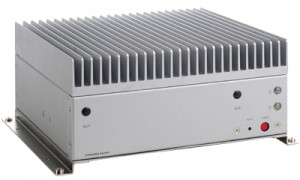Heat Sink Module for Fanless Embedded Computers
The thermal heat sink module used in desktop CPU evolved Review the course of development for Intel and AMD CPU heat with the work clock enhance The embedded computer thermal design has been presented with the launch of the new CPU and a different look, from the form of the radiator, the selection of materials to the selection of the fan significantly change.
A. aluminum copper heat sink
DT (desktop) CPU heat than the CPU NB (mobile) is much higher, but because of its spacious, maintain greater flexibility in the design of electronic cooling. The early CPU heat is low, the cooling means is mainly based on the aluminum fins, and then with a forced cooling fan, i.e. a so-called air-cooled radiator (Air-Cooled Heat Sink). Production of aluminum heat sink aluminum extrusion (Extrusion) Casting (Casting), folding (Folding), then (Bonding), forging (forging), cutting (Skiving) imprint
(Stampings), improved die-casting (Modified die-casting) and mechanical precision machining (Machining), processing, and applications have their own advantages and disadvantages and ability to limit, but are sufficient to meet the cooling requirements, with aluminum extrusion the lowest cost, the best yield, the highest share.
However, with the rapid evolution of the CPU, the aluminum heat sink gradually facing a bottleneck, thus the birth of the pure copper heat sink. Copper thermal conductivity is 1.77 times that of aluminum, copper heat sink, high price, weight, processing, and applications limited, it is difficult to low-cost production. The most common application of copper as the base plate of the heat sink, junction type fin bent fins or aluminum extrusion heat sink for welded joints or machine bonding in order to reduce the weight of the heat sink, and enhance the cooling module performance.
But after all mainly air-cooled heat sink cooling bottleneck, therefore the continued development of a new generation of cooling technology, such as the heat sink combined with the heat pipe and plate heat pipe, water-cooling device (Closed Loop Water Cooling, Liquid Jet. Theoretical Model for Spray Droplet Impingement Cooling, Liquid Spray Cooling) of TEC (Thermoelectric Cooling).
B. combined heat pipe
The heat pipe (liquid, gas) and the vapor flow of a heat transfer apparatus using two changes. The working principle is the low pressure within the heat pipe, the working fluid can be evaporated at about 30 ° C when the working fluid condenses into a liquid in the high temperature absorbs heat to evaporate at a temperature CPU, after the release of heat flow to the distal fins, and then by capillary The structure provided by the capillary force back into the high-temperature side. Heat pipe is mainly used in NB, because of its light weight and high thermal conductivity characteristics, DT (desktop) began to heat pipe into the design of the cooling module.
C. combination of the plate-type heat pipe
Plate-type heat pipe practices with heat pipe, so when the contact plate-type heat pipe local position with a smaller area of the heating element, the working fluid of the plate-type heat pipe here due to heat is saturated under, so rapid evaporation (endothermic) . Its vapor due to higher pressure and flow to the plate at the lower pressure, the actual occurrence of localized heat can be transmitted by the working fluid liquid-vapor phase change to the board all the space, and then through a larger area of the surface or the surface of the skin graft The additional heat sink is distributed in the atmosphere, with good thermal diffusivity and temperature uniformity. Plate-type heat pipe heat sink, the heat pipe heat sink (Heat Pipe Heat Sink), and help reduce the thermal resistance packaging, and more to enhance the cooling effect.
D. high thermal conductivity composites
The ideal electronic packaging and heat dissipating material to have the characteristics of high thermal conductivity, low density and low thermal expansion coefficient, to meet the above characteristics have non-traditional (monolithic) separate material, such as copper, aluminum attainable, but must be applied to The combination of two or more kinds of materials. In all the advanced thermal management materials, carbon fiber composite material (Carbon Fiber Reinforced Composites) due to having a high thermal conductivity conductivity (higher than that of copper), while having a ratio of aluminum, copper, etc.
Lower density and coefficient of thermal expansion, and regarded as a potential thermal management materials.
Source - Money DJ Finance Knowledge Base




